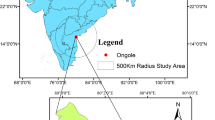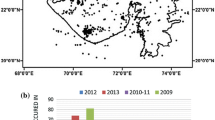Abstract
Economic importance of major ports is well known, and if ports are located in seismically active regions, then site-specific seismic hazard studies are essential to mitigate the seismic risk of the ports. Seismic design of port sites and related structures can be accomplished in three steps that include assessment of regional seismicity, geotechnical hazards, and soil structure interaction analysis. In the present study, site-specific probabilistic seismic hazard analysis is performed to identify the seismic hazard associated with four typical port sites of Gujarat state (bounded by 20°–25.5°N and 68°–75°E) of India viz. Kandla, Mundra, Hazira, and Dahej ports. The primary aim of the study is to develop consistent seismic ground motion for the structures within the four port sites for different three levels of ground shaking, i.e., operating level earthquake (72 years return period), contingency level earthquake (CLE) (475 year return period), and maximum considered earthquake (2,475 year return period). The geotechnical characterization for each port site is carried out using available geotechnical data. Shear wave velocities of the soil profile are estimated from SPT blow counts using various empirical formulae. Seismicity of the Gujarat region is modeled through delineating the 40 fault sources based on the seismotectonic setting. The Gujarat state is divided into three regions, i.e., Kachchh, Saurashtra, and Mainland Gujarat, and regional recurrence relations are assigned in the form of Gutenberg-Richter parameters in order to calculate seismic hazard associated with each port site. The horizontal component of ground acceleration for three levels of ground shaking is estimated by using different ground motion attenuation relations (GMAR) including one country-specific GMAR for Peninsular India. Uncertainty in seismic hazard computations is handled by using logic tree approach to develop uniform hazard spectra for 5% damping which are consistent with the specified three levels of ground shaking. Using recorded acceleration time history of Bhuj 2001 earthquake as the input time motion, synthetic time histories are generated to match the developed designed response spectra to study site-specific responses of port sites during different levels of ground shaking. It is observed that the Mundra and Kandla port sites are most vulnerable sites for seismic hazard as estimated CLE ground motion is in order of 0.79 and 0.48 g for Mundra and Kandla port sites, respectively. Hazira and Dahej port sites have comparatively less hazard with estimated CLE ground motion of 0.17 and 0.11 g, respectively. The ground amplification factor is observed at all sites which ranges from 1.3 to 2.0 for the frequency range of 1.0–2.7 Hz. The obtained spectral accelerations for the three levels of ground motions and obtained transfer functions for each port sites are compared with provisions made in Indian seismic code IS:1893-Part 1 (2002). The outcome of present study is recommended for further performance-based design to evaluate the seismic response of the port structures with respect to various performance levels.











Similar content being viewed by others
References
Abrahamson NA (1998) Non-stationary spectral matching program RSPMATCH. Pacific Gas & Electric Company, Internal Report
Abrahamson NA, Silva WJ (1997) Empirical response spectral attenuation relations for shallow crustal earthquakes. Seismol Res Lett 68:94–127
Ahmad SM, Choudhury D (2008) Pseudo-dynamic approach of seismic design for waterfront reinforced soil wall. Geotext Geomembr 26:291–301. doi:10.1016/j.geotexmem.2007.12.004
Anbazhagan P, Vinod JS, Sitharam TG (2009) Probabilistic seismic hazard analysis for Bangalore. Nat Hazards 48:145–166
Bilham R, Gaur VK, Molnar P (2001) Himalayan seismic risk. Science 293:1442–1444
Biswas SK (2005) A review of structure and tectonics of Kutch basin, western India, with special reference to earthquakes. Curr Sci 88:1592–1600
Bonilla MG, Mark RK, Lienkaemper JJ (1984) Statistical relations among earthquake magnitude, surface rupture length and surface fault displacement. Bull Seismol Soc Am 74:2379–2411
Boore DM, Joyner WB, Fumal TE (1997) Equations from estimating horizontal response spectra and peak acceleration from Western North American earthquakes: a summary of recent work. Seismol Res Lett 68:128–153
Campbell KW (1997) Empirical near-source attenuation relationships for horizontal and vertical components of peak ground acceleration, peak ground velocity, and pseudo-absolute acceleration response spectra. Seismol Res Lett 68:154–179
Choudhury D, Ahmad SM (2007a) Stability of waterfront retaining wall subjected to pseudo-static earthquake forces. Ocean Eng 34:1947–1954. doi:10.1016/j.oceaneng.2007.03.005
Choudhury D, Ahmad SM (2007b) Design of waterfront retaining wall for the passive case under earthquake and tsunami. Appl Ocean Res 29:37–44. doi:10.1016/j.apor.2007.08.001
Choudhury D, Ahmad SM (2008) Stability of waterfront retaining wall subjected to pseudo-dynamic earthquake forces. J Waterw Port Coast Ocean Eng ASCE 134:252–260. doi:10.1061/(ASCE)0733-95OX(2008)134:4(252)
Choudhury D, Savoikar P (2009) Equivalent-linear seismic analyses of MSW landfills using DEEPSOIL. Eng Geol 107:98–108
Choudhury D, Shukla J (2011) Probability of occurrence and study of earthquake recurrence models for Gujarat state in India. Disaster Adv 4:47–59
Choudhury D, Subba Rao KS (2002) Seismic passive resistance in soils for negative wall friction. Can Geotech J 39:971–981. doi:10.1139/T02-023
Choudhury D, Sitharam TG, Subba Rao KS (2004) Seismic design of earth retaining structures and foundations. Curr Sci 87:1417–1425
Cornell CA (1968) Engineering seismic risk analysis. Bull Seismol Soc Am 58:1583–1606
Dash SR, Govindraju L, Bhattacharya S (2008) A case study of damages of the Kandla port and customs office tower supported on a mat-pile foundation in liquefied soils under the 2001 Bhuj earthquake. Soil Dyn Earthq Eng 29:333–346
Dikmen U (2009) Statistical correlations of shear wave velocity and penetration resistance for soils. J Geophys Eng 6:61
Frankel A, Mueller C, Barnhard T, Perkins D, Leyendecker EV, Dickman N, Hanson S, Hopper M (1996) National seismic hazard maps: documentation June 1996. Open-File Report, United States Geological Survey, 96-532, 41
GSI (2000) Seismotectonic Atlas of India and its environs. Geological Survey of India, Spec. Publ. No. 59, Kolkatta
Gupta ID (2006) Delineation of probable seismic sources in India and neighborhood by a comprehensive analysis of seismotectonic characteristics of the region. Soil Dyn Earthq Eng 26:766–790
Gutenberg B, Richter CF (1944) Frequency of earthquakes in California. Bull Seismol Soc Am 34:185–188
Idriss IM (1990) Response of soft soil site during earthquakes. In: Duncan JM (ed) Proceedings of H. Bolton seed memorial symposium, vol 2. University of California, Berkeley, pp 273–289
Idriss IM, Sun JI (1992) User’s manual for SHAKE91: a computer program for conducting equivalent linear seismic response analyses of horizontally layered soil deposits. Center for Geotechnical Modeling, Dept. of Civil & Environmental Engineering, University of California, Davis
Imai T (1977) P and S wave velocities of the ground in Japan. In: Proceeding of IX international conference on soil mechanics and foundation engineering, vol 2, pp 257–260
Imai T, Tonouchi K (1982) Correlation of N-value with S-wave velocity and shear modulus. In: Proceedings of the 2nd European symposium of penetration testing, Amsterdam, pp 57–72
Imai T, Yoshimura Y (1970) Elastic wave velocity and soil properties in soft soil (in Japanese). Tsuchito-Kiso 18(1):17–22
IS:1893 (Part-1) (2002) Criteria for earthquake resistant design of structures—general provisions and buildings. Bureau of Indian Standard, New Delhi
Iyisan R (1996) Correlations between shear wave velocity and in situ penetration test results (in Turkish) Chamber of Civil Engineers of Turkey. Teknik Dergi 7(2):1187–1199
Jafari MK, Asghari A, Rahmani I (1997) Empirical correlation between shear wave velocity (Vs) and SPT-N value for south of Tehran soils. In: Proceedings of the 4th international conference on civil engineering, Tehran (in Persian)
Madabushi SPG, Haigh SK (2005) The Bhuj, India earthquake of 26th January 2001. A field report by EEFIT. Institution of Structural Engineers, London
Malik JN, Sohoni PS, Karanth RV, Merh SS (1999) Modern and historic seismicity of Kachchh Peninsula, Western India. J Geol Soc India 54:545–550
McGuire RK (1976) FORTRAN computer program for seismic risk analysis. USGeological Survey, Open-File Report, 76-67
Mhaske SY, Choudhury D (2010) GIS-based soil liquefection susceptibility map of Mumbai city for earthquake events. J Appl Geophys 70:216–225. doi:10.1016/j.jappgeo.2010.01.001
Mhaske SY, Choudhury D (2011) Geospatial contour mapping of shear wave velocity for Mumbai city. Nat Hazards 59:317–327. doi:10.1007/s11069-011-9758-z
Nowroozi AA (1985) Empirical relations between magnitudes and fault parameters for earthquakes in Iran. Bull Seismol Soc Am 75:1327–1338
Petersen MD, Rastogi BK, Schweig GES, Harmsen SC, Gomberg JS (2004) Sensitivity analysis of seismic hazard for the northwestern portion of the state of Gujarat, India. Tectonophysics 390:105–115
Phanikanth VS, Choudhury D, Reddy GR (2011) Equivalent-linear seismic ground response analysis of some typical sites in Mumbai. Geotech Geol Eng 29:1109–1126. doi:10.1007/s10706-011-9443-8
PIANC/MarCom WG34 (2001) Seismic design guidelines for port structures. International Navigation Association. A.A. Balkema, Lisse
Pitilakis K (2004) Site effects. In: Ansal A (ed) Recent advances in earthquake geotechnical engineering and microzonation. Kluwer, Dordrecht
Raghu Kanth STG, Iyengar RN (2006) Seismic hazard estimation for Mumbai city. Curr Sci 11:1486–1494
Raghu Kanth STG, Iyengar RN (2007) Estimation of seismic spectral acceleration in peninsular India. J Earth Syst Sci 3:199–214
Rastogi BK (2004) Damage due to the M w 7.7 Kutch, India earthquake of 2001. Tectonophysics 390:85–103
Roblee C, Chiou B (2004) A proposed Geoindex model for design selection of non-linear properties for site response analysis. In: International workshop on uncertainties in nonlinear soil properties and their impact on modeling dynamic soil response. PEER Headquarters, UC Berkeley, 18–19 March
Sadigh K, Chang CY, Egan JA, Makdisi F, Youngs RR (1997) Attenuation relations for shallow crustal earthquakes based on California strong motion data. Seismol Res Lett 68:180–189
Seed HB, Idriss IM (1970) Soil moduli and damping factors for dynamic response analysis. Report No EERC 70-10, Earthquake Engineering Research Center, University of California, Berkeley
Seed HB, Idriss IM (1981) Evaluation of liquefaction potential sand deposits based on observation of performance in previous earthquakes. ASCE National Convention, (MO), 81–544
Seed HB, Wong RT, Idriss IM, Tokimastu K (1986) Moduli and damping factors for dynamic analysis of cohesionless soils. J Geotech Eng ASCE 112(11):1016–1032
Shukla J, Choudhury D (2011) Estimation of seismic ground motions using deterministic approach for major cities of Gujarat. Natural Hazards and Earth System Sciences, Germany (accepted, in press for publication)
Slemmon DB (1989) Determination of earthquake size from surface faulting events. In: Proceedings of international seminar on Seismic Zoning, China
Sokolov VY (2000) Site & region-specific response spectra: a probabilistic approach. Soil Dyn Earthq Eng 20:273–281
Subba Rao KS, Choudhury D (2005) Seismic passive earth pressures in soils. J Geotech Geoenviron Eng ASCE 131:131–135. doi:10.1061/(ASCE)1090-0241(2005)131:1(131)
Sun JI, Golesorkhi R, Seed HB (1988) Dynamic moduli and damping ratios for cohesive soils. EERC Report No. UCB/EERC-88/15
Takahashi A, Takemura J (2005) Liquefaction induced large displacement of pile supported wharf. Soil Dyn Earthq Eng 25:811–825
Toro GR, Abrahamson NA, Schneider JF (1997) Model of strong ground motions from earthquakes in central and eastern North America: best estimates and uncertainties. Seismol Res Lett 68:41–58
Tripathi JN (2006) Probabilistic assessment of earthquake recurrence in the January 26, 2001 earthquake region of Gujarat. India J Seismol 10:119–130
Vucetic M, Dobry R (1991) Effect of soil plasticity on cyclic response. J Geotech Eng ASCE 117:89–107
Wells DL, Coppersmith KJ (1994) Updated empirical relationships among magnitude, rupture length, rupture area and surface displacement. Bull Seismol Soc Am 84:4–43
Werner SD (ed) (1998) Seismic guidelines for ports. Technical Council on Lifeline Earthquake Engineering Monograph No. 12, ASCE
Yadav RBS, Tripathi JN, Rastogi BK, Chopra S (2008) Probabilistic assessment of earthquake hazard in Gujarat and adjoining regions of India. Pure Appl Geophys 165:1813–1833
Yadav RBS, Papadimitriou EE, Karakostas VG, Shanker D, Rastogi BK, Chopra S, Singh AP, Kumar S (2010) The 2007 Talala, Saurashtra, western India earthquake sequence: Tectonic implications and seismicity triggering. J Asian Earth Sci 40:303–314
Author information
Authors and Affiliations
Corresponding author
Rights and permissions
About this article
Cite this article
Shukla, J., Choudhury, D. Seismic hazard and site-specific ground motion for typical ports of Gujarat. Nat Hazards 60, 541–565 (2012). https://doi.org/10.1007/s11069-011-0042-z
Received:
Accepted:
Published:
Issue Date:
DOI: https://doi.org/10.1007/s11069-011-0042-z




